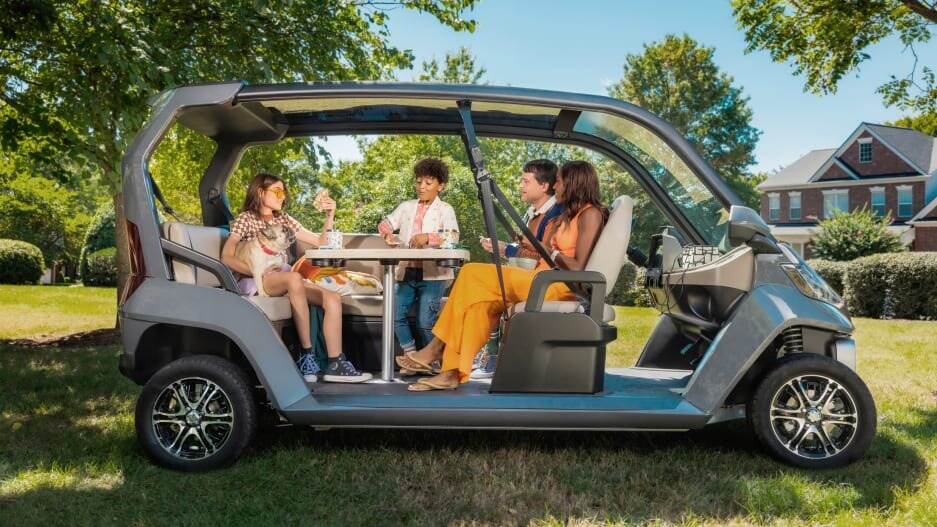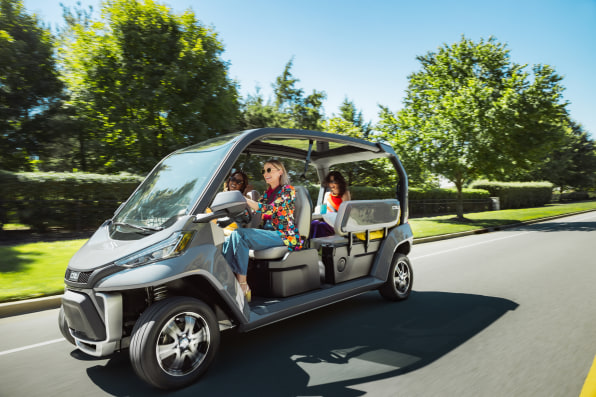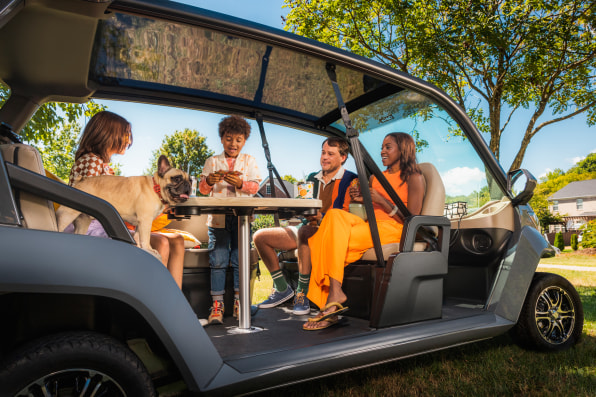- | 3:00 pm
Why BMW just redesigned the humble golf cart
At $29,000, it may well be the most expensive micromobility vehicle ever made, but it also doubles as a socializing space while parked.

Americans drive an average of 13,474 miles a year, or the equivalent of four roundtrips from New York to Dallas. Almost half of those car trips, however, are under three miles. That’s a lot of unnecessary gas (both the petrol and greenhouse kind) spent for journeys that don’t necessarily require a car. But one company has come up with an unusual solution: golf carts. Well, sort of.
Club Car, one of the country’s leading golf cart companies, has launched a whole new breed of electric micromobility vehicle that looks like an oversized golf cart but works like a low-speed car—and even meets automotive safety standards. The Cru was designed by BMW’s design innovation studio, Designworks, whose external client roster includes Singapore Airlines, Siemens, and John Deere. (Designworks was only involved in the vehicle’s design and BMW will not earn any revenue or royalties from Club Car’s sales.)

The CRU is narrower than a standard car yet longer than a golf cart, making for a roomier, flexible interior that can turn into a socializing space in seconds. With a speed limit of 25 miles per hour, it’s only as fast as most electric scooters on the market, but it is street legal and can be driven on any street with a speed limit of 35 mph or lower, making it a viable alternative for any short trips taken at both neighborhood and city-wide scale. As micromobility solutions go, it’s an intriguing move—and at $27,000 a pricey one at that. But in the micromobility market, which is already ripe for disruption, it could drive the practice even further.

Golf carts aren’t just fit for turf grass. They are already ubiquitous in suburban enclaves like The Villages in Florida and Peachtree City in Georgia. And earlier this year, Tampa welcomed its first golf cart rental business, with street-legal golf carts. In 2016, Club Car, which had largely focused on golf carts until then, launched Onward, a highly customizable family of vehicles that you could take to the golf course, or use to cruise around a master-planned community (the company has since sold over 150,000 units).

The CRU, however, is a whole other beast. Sure, you can drive the vehicle on roads beyond gated communities (it has a battery range of about 30 miles). But what sets it apart from other low speed vehicles on the market is that the experience it offers when parked.
Indeed, one of the CRU’s primary use cases is to accommodate group and family hangouts: Just park it, and bring out the party favors. A wrap-around lounge can accommodate three seat-belted adults (or four kids if they squeeze in without seatbelts on while the vehicle is parked). Meanwhile, both driver and passenger seats can flip back and forth so that the front passengers can sit face to face with their backseat companions—a bit like in a diner booth. A removable table at the center lets you play boardgames or have a bite; you can stow it away under the seats, but you don’t have to while the vehicle is in motion. “The vehicle layout and design makes the vehicle as much a part of the destination as the place you’re going to, and it’s something you can use at the destination as part of your experience,” says Ross Atherton, the vice president and general manager of Club Car.

Four years in the making, the concept was informed by substantial consumer research, during which the team even learned that people enjoy taking their golf carts to visit friends and hang out inside them—a bit like bringing their own furniture on wheels. “They would sit in their driveways, both in golf carts facing each other,” says Atherton. As for the design, inspiration came from further afield: yachts. “The main hangout place of a yacht is the open air rear, where you often have a wrapping lounge,” says Johannes Lampela, director of design at Designworks. Many boat owners often socialize on their boats while docked in the marina.

With CRU, Designworks sought to replicate that experience on land, all the way down to the indoor-outdoor nature of a yacht: “You have the comfort of the inside but you’re actually outside,” says Lampela. You can even flip the windshields open like in a golf cart. And because the CRU is also designed to go on roads, the vehicle is only open on the side of that faces the curb (instead of both sides like in a standard golf car), while the side that faces the road is enclosed by a window.
The designers went through a dozen iterations before they landed on this particular configuration, building a plywood skeleton that they sat inside while wearing VR to visualize the design). The final version is made of a durable, corrosion-resistant aluminum frame, automotive quality fabrics, and automotive grade windshield that’s approved by the Department of Transportation.
For now, the open-air nature of the vehicle is best suited to warmer climates, which is why Club Car is first launching in cities across Florida, South and North Carolina, Texas, Southern California, and Arizona. But Atherton says that fully enclosed windows are “on our product roadmap.”
The CRU comes in a variety of customizable options, including a sound system, and a tinted panoramic roof. It’s available in a notably grayscale palette of “Magnesium Silver, “Pearl Spectre White,” and “Tuxedo Black,” with sandy beige interiors. At $29,000 (if you opt for the panoramic roof) it is decidedly more expensive than a six-seater golf cart, which start at around $14,000. It’s also as expensive as some of the cheapest electric cars on the market—and that’s without federal rebates. But in the end, it’s neither one, nor the other. As Lampela puts it, “it’s a friendly neighborhood vehicle,” which may well be the only scenario where those two words don’t sound like an oxymoron.








































